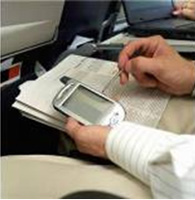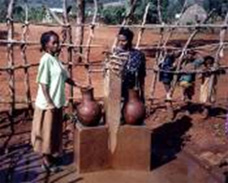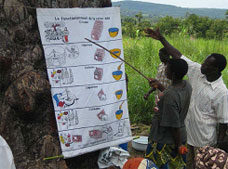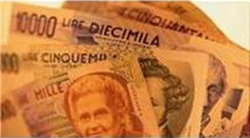1) What is involved ?
The principle of water pricing and its various payment systems raise numerous questions and are or great importance for all water users, especially since prices are generally on the increase and becoming a significant part of household budgets, given the relative scarcity of the resource and its frequent pollution.
Before we examine the various water pricing and invoicing systems, and in particular the various types of social and solidarity pricing policies, or aid for the most deprived, we need to have a closer look at the justification and components of the price of water, i.e. what users are billed for, who decides it and what is meant by affordable water price.
2) Who use this means and since when ?
Water is invoiced to users in a variety of ways but practically everywhere and at extremely variable prices, some being very low, especially in certain rural or poor areas, while others are very high, in particular where complex treatments or facilities are required.
To an increasing extent, the price of wastewater treatment, where this is done by the municipalities, is added to the previous price and is often similar.
But water hasn’t always been charged for everywhere. At an earlier period, especially when the water of lakes and rivers was relatively pure and required practically no treatment, water was often totally or almost free, except in cities where water collection and distribution networks had to be built. Moreover, a few rare countries such as Ireland and South Africa supply all or part of the water free of charge, as it is financed by the state through taxation.
3) Why invoice water ?
Water, as a natural resource which is indispensable to everyone’s life, is of course a free commodity. However, its collection, treatment and distribution, as well as the treatment of wastewater before it is returned to nature, require more or less significant technical, financial and human resources which are sometimes complex and have a cost which needs to be paid for one way or another.
Thus, we mustn’t mix up water resources (rivers, groundwater, etc.), which are free public resources, with public water services, which consist in collecting this drinking water and supplying it to households (individual connection), or as close as possible to everyone (community wells, public standpipes, etc.), and have a cost.
4) Who is primarily concerned ? Places or contexts in which this method seems most appropriate
Almost everyone is concerned. However, pricing and invoicing systems must be well-suited and affordable, especially for the most deprived.
They are numerous such systems, as we will see.
5) What does the price of water depend on ? Who sets it ? How is it invoiced and collected ?
a) What does the price of water depend on ?
It varies significantly from one country to the next, and even from one region or municipality to the next. This variation depends to a minor extent on the public, private, mixed or community nature of the service, but mainly on the conditions involved in providing the resource (water collection, quality, distance, cost and age of the facilities, etc.) and complexity of treatment and distribution systems (simple or non-existent network, service provided to users, simplified invoicing, etc.).
Thus, the cost of water pulled up in a bucket from a well will be totally different from that of water produced in a modern treatment plant using surface water which is more or less polluted by agricultural and industrial activities.
Likewise, as water is a local commodity whose long-distance transport is costly, its price essentially depends on the geographical, geological and economic conditions prevailing in the communities where it is produced and which set its price.
The price of water can thus range from a few cents to €5 per cubic metre, or even more in rare cases.
For instance, in 2010, the average price of water ranged from a few cents in numerous African regions with public standpipes to €1.60 € in Spain, €2.70 in Sweden, €2.92 in France, €3.90 in the Netherlands, €5.10 in Germany and €5.60 in Denmark.
b) What does the cost of water comprise ? What is the difference between the cost of water and its price ? What do users pay for ?
It is necessary to distinguish between the cost of water, which corresponds to the real cost of its production and distribution for the firm which produces it and the price of water which is the part of this cost invoiced to users, which is most often higher, but which is sometimes low or even insufficient to ensure the quality, maintenance and renewal of facilities.
 What does the real cost of water comprise ?
What does the real cost of water comprise ?
It comprises construction costs, amortisation expenses and provisions for the replacement of all water collection, treatment and distribution facilities, as well as the cost of treatment, operation and maintenance, including that of the pipe network, administrative and customer management services (when they exist), and resource preservation costs.
On top of those costs, taxes of various kinds, of sometimes significant amounts, are most often charged by local authorities or the state.
In regions where there are also sanitation and wastewater treatment services, their cost are often added.
What costs should users pay ?
Experts are often been divided between two schools of thought : according to international experts, that of "full cost recovery" and that of "sustainable cost recovery".
Full cost recovery consists in getting users to pay for the total cost of water, as detailed above. This is what large international institutions such as BIRD used to advocate over the past decades, including in developing countries, which seemed to make sense to ensure the proper operation and sustainability of the facilities, but which led to several resounding failures.
How can populations, which are often deprived, be asked to fully finance in the space of a few years, what the populations of most developed countries managed to achieve in nearly a hundred years with the help of significant external aid or financing ?
Therefore, the "sustainable cost recovery" model has imposed itself in most cases. While experts are divided on the components that need to be taken into consideration – which may vary according to situations – most of them agree that the price to be paid should at least be equal to the operating, treatment, and maintenance costs, while construction and amortisation expenses, or at least the largest part of those costs, should be covered by grants and external financing from the state and/or international bodies.
Note that a more restricted school of thought, like in India and Egypt, sees grants as a major factor.
c) Who sets the price of water and how ?
 This depends on the countries, or even regions in some of them.
This depends on the countries, or even regions in some of them.
But, in most countries, the authority which organises the water service (the municipality, regional authority or group of municipalities) sets the price of the water, as well as that of sanitation, while most taxes are set by the state. The price is set by the public authority only if it manages the service directly. If the service is delegated to a private company, the price is set by the municipality after negotiation of a medium or long-term contract between the two parties, setting out the operating conditions and service monitoring terms and determining the price variation terms for the entire period.
However, in numerous regions, especially the rural and suburban areas of developing countries, Management Committees or Residents Associations managed by the latter have taken the initiative to create and manage local water or sanitation services. Consequently, they make the decisions for such facilities and set the prices or amount of the fees (See factsheets C5 to C8).
d) What are the main invoicing and recovery systems ?
This all depends on the place where people live and whether or not water meters are used.
In certain rural areas of developing countries, a flat fee is charged. Its amount sometimes varies and depends on the type of use (domestic, agricultural, large family, etc.) and an estimate of the usual amount of water consumed.
The flat-fee system is far from being the most widespread and is only applied when water consumption is fairly low and homogeneous among the population. It’s an option chosen by the community.
But, in most cases, especially in places where meters are used, water is invoiced by volume, usually by cubic metre, based on periodic readings covering periods of various lengths and paid (either in advance or after consumption, depending on the places) by the users by cheque or in cash in dedicated offices or agencies.
However, in numerous countries, water is only partly invoiced by volume, as a "two-part tariff" is applied, consisting of a fixed fee independent of consumption (often called a "standing charge" like for electricity or the phone) and a variable charge depending on the number of cubic metres consumed.
We will see later on that, irrespective of the chosen system, invoicing can be done according to various pricing systems which can have a fairly significant impact, especially for low-income persons.
When there are no meters, the most common types of invoicing are the following :

Standpipe. Photo Interaide
- another type of payment per volume which is fairly widespread in the rural and suburban areas of developing countries is the payment per water container or bucket. This is most often the case at water standpipes.
In such cases, the water is often sold per litre or per container by small private concession-holders or managers. But, in certain regions, the water from standpipes is free.
It is now sometimes sold via prepaid tokens or magnetic cards, a solution which is often seen as controversial when it is not accompanied by the issuing of free or reduced-price cards to the poorest by the public authorities for a minimum volume of water.
- Payment by volume, but through a periodic or annual fee is also frequent and either depends on the type and/or estimated quantity of water used by the person, or is set on a flat-rate basis.

Training of a Togo village Committee in
the management of cash and payments
In rare cases, in certain villages :
- payment of a cash contribution requested only after the harvest period.
- payment in kind, after the harvest (cereal, fruit, vegetables) or in return for work, or totally or partially free of charge for families without income in certain villages.
Example : In Africa, in the village of Koulbagou, after the millet or sorghum harvest, each family who owns a field must give one bail of cereal for every 30 harvested, while no contribution is required of villagers harvesting less than 30 bails.
- collective payment, from the resources of certain village communities (use of the profits made by community enterprises, production cooperatives, etc.)
- payment linked to events. Unusual example in Safatan : to reduce charges, the Management Committee decided to charge 200 CFA francs, i.e. €0.30 for each marriage, christening, major festivity, etc.
e) What are the main pricing systems ?
In addition to the three main pricing systems already described (flat fee, by volume or mixed), there are several variants to those systems, most often grouped together under the name of social pricing or solidarity pricing.
All of these other pricing systems are described in factsheets B3 to B8. Their goal is usually to create a first consumption bracket at a reduced price and subsequently increase the price of water by brackets according to the quantity of water consumed. They aim to protect the resource by reducing consumption. However, such systems can also have adverse effects, in particular for deprived or large families, which may be rectified through more solidarity pricing or social aid (See factsheet B8).
6) The notion of affordable water tariffs
 The resolution of the 2101 UN General Meeting which recognised every person’s right to water states that it should be fit to drink and easily accessible but also that it should be financially affordable for everyone, but without specifying how.
The resolution of the 2101 UN General Meeting which recognised every person’s right to water states that it should be fit to drink and easily accessible but also that it should be financially affordable for everyone, but without specifying how.
In France, a law in 2006 had already stated that "each person has the right to access drinking water under economically acceptable conditions", but without defining them either.
But several United Nations bodies were a little more specific, estimating that, irrespective of the country, the water budget of households should not exceed a certain percentage of their resources : 5 % for the World Bank and Asian Development Bank, given the current situation in many developing countries where it often varies between 4 and 8%, or even more ; 4% for the OECD and European Commission, but only 3% for the UNDP and UNICEF. There is therefore no universal standard in this respect.
By way of comparison, note that in France, the average amount of water bills (including sanitation), which vary from one region to the next, is equivalent to 0.7 % of the average net income of households and that it is below 2% in most developed countries. But, it is much higher for the poor, for whom it may reach 3.5 to 5% in France and even more in certain OECD countries (see graph below).
Most NGOs have adopted the UNDP recommendation, which has also inspired certain law bills. Thus, in France, a proposal was submitted to Parliament to compensate all users with water bills 3% above that level, through individual subsidies financed by a 0.5% tax on the price of water. This bill has been approved by the Senate but has not yet been ratified by the National Assembly.
Weight of the average water and sanitation bill in the net average available income of poor households in OECD countries
(Source OECD 2009 "Pricing water resources and water and sanitation services") 
7) Specific difficulties and precautions to be taken
The large variety of invoicing and pricing systems shows that the problems are not so simple and that special attention must be paid to the particular socio-economic context, such as the populations’ financial means. Moreover, when establishing a pricing system, it is essential to define exactly who pays what and how, with the understanding that what is not paid by one portion of the population will need to be paid by the others.
It is very difficult to ask a population, which until then paid nothing or very little for water, to pay more for the construction or modernisation of facilities. Certain public authorities may thus be tempted to recover an amount which is much lower that actual costs, but experience has shown that this was akin to mortgaging the future and rapidly becoming incapable of supplying a proper, sustainable service. Moreover, when determining the realistic efforts to be requested, it is important to ensure that the specific situation of the poorest is taken into account.
The terms "social pricing" and "solidarity pricing" are very general and not necessarily the most appropriate. When you read documents, it is therefore necessary to strive to find out what is actually meant, and what the impacts will be for the various categories of persons concerned, especially the most fragile, through economic simulations.
Moreover, before making any decision, it is advisable to find out what the population mainly expects, examine the changes in invoicing they may engender, compare them to the average amount of annual fees previously collected (e.g., for 120 m3/year, approximately €440 in France, €210 in Spain and €500 in the UK) and examine whether they are significant enough to warrant the set-up of such a pricing system.
8) Achievement examples
Numerous examples are given in factsheets B3 to B8 concerning the various pricing systems.
9) Where to obtain further information ?
a) Websites
- OECD : "The price of saving water". Interesting 2-page brief on water pricing problems.
Available online at :
http://www.oecdobserver.org/news/fu...
- CIE (Centre d’information sur l’eau) : two summary factsheets concerning the components of the cost of water and its pricing in France :
- "Comprendre le prix de l’eau" to understand the price of water and its main components, available at :
[http://www.cieau.com/le-service-public/prix-services-eau-assainissement/le-prix-des-services-de-l-eau-et-de-l-assainissement->http://www.cieau.com/le-service-public/prix-services-eau-assainissement/le-prix-des-services-de-l-eau-et-de-l-assainissement].
- "A produit local prix local" explaining the reasons for price differences according to places and who sets the price of water, available at
[http://www.cieau.com/le-service-public/prix-services-eau-assainissement/le-prix-des-services-de-l-eau-et-de-l-assainissement->http://www.cieau.com/le-service-public/prix-services-eau-assainissement/le-prix-des-services-de-l-eau-et-de-l-assainissement].
- Académie de l’eau : publication of several very interesting, well-documented illustrated studies by Mr Henri SMETS, President of ADEDE and prominent specialist in all pricing systems :
- "De l’eau potable à un prix abordable", 254-page book explaining the concept of affordable water prices and comprising an extensive appendix showing numerous examples and graphs illustrating pricing practices in numerous countries.
- "La tarification progressive en France et dans le monde", 138-page book published in 2011, with a summary on pages 9 to 12, showing, through numerous examples and graphs referring to specific cases, the various ways of setting up an equitable pricing system to keep the price of one litre of water at the same level for the maximum number of people irrespective of the size of the household, but lower for the poor.
- UNDP : "Human Development Report 2006". This long and very interesting report contains a wealth of information and figures on water and sanitation problems across the world, and in particular on pricing and aid issues (pages 84 to 86 and 97 to 99). Available online at : http://hdr.undp.org/en/media/HDR_20...
b) Video
You Tube : OECD : "Water - The right price can encourage efficiency and investment", 3½ minute interview of OECD Secretary-General on the need and interest of setting the right price.
http://www.oecd.org/document/31/0,3...










